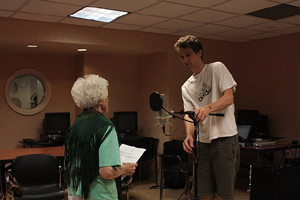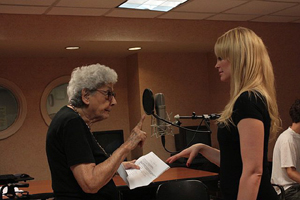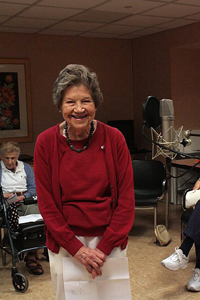Psyched on Sonics: Recording Voices in Challenging Locations
Every month, Matt McCorkle of EqualSonics.com brings you a day in the life of a New York City recording engineer.
The Mission: Recording Voices In An Unconventional Recording Space
In October of last year I was contacted by Whitney Bryant of the Tuesdays at Four company, inquiring about mobile recording services. She heads an intergenerational class held on Tuesdays at 4pm inside the The Hallmark of Battery Park Senior Residence. The class’ mission is to promote healthy aging via means of movement, community and the arts.
Her concept was to record the members of her class, who vary in age from 18 to 101, as they answered broad life questions and shared their stories. The idea was to later arrange these monologues and dialogues in a sequence that tells a bigger story. “I Was I Am We Are” was the name for the project and the recording and the questions to which the participants would attempt to answer.
After communicating via e-mail about the process for recording and the eventual editing necessary to create the desired cohesive spoken word recording, it was time to meet the class and scope out the room in which I would be recording.
Analyzing The Hallmark
Whenever I have the opportunity to scope a location prior to recording, I take advantage of that to obtain a clear perspective of what I’m walking into so that I can troubleshoot ahead of time and maximize efficiency come recording time. Upon my initial arrival at The Hallmark, I met Whitney and she gave me a tour of the space. Quickly, I was able to get a good sense of what I was dealing with.
It was a large room with florescent lights. The lights sparked immediate concern due to the noise they often generate, however, even up close, the lights were relatively quiet. The central air, however, which came on periodically, was loud! I asked Whitney about this and she said the central air can be turned off for each room, easy enough.
I walked around the room whistling short bursts of air. This particular exercise helps me determine the acoustics of the room:
- I whistle one note and then listen to the decay on the echo, the timbre of my whistle and the sound of my whistle in the room.
- I whistle one a little lower in pitch, then listen.
- Finally I whistle a couple more pitches to know how the room responds to various frequencies.
The ceilings were about 13 feet high, high enough to avoid ugly reflections from bouncing around, so I was confident that the space wouldn’t be an issue. The great thing about this approach is that I always have my whistling with me!
Each resident will be speaking into the same mic, one at a time. Three groups of 8-10 people for one hour each.
My plan was to setup a cardioid condenser mic in the central-most part of the room. The room sounded clearest and most neutral in the center without the ugly reflections that were generated closer to the walls. I felt good about the location and confident that my setup would yield great results having been able to take this initial inventory of the space.
Establish Homebase
Arriving a few days after my initial scope out of the room, it was time to record. I setup Equal Sonics Mobile in a far corner away from the center of the room.
After booting up my hard drives, laptop and Pro Tools I was ready to go. I setup a Neumann U87 in the center of the room and switched the polar pattern to cardioid. I ran an XLR cable from the mic to the rig, tucking it under tables, to keep the area clear.
The last thing to do was to set up headphones beside the mic for each speaker to use. I ran a HearBack mixer to the center of the room and placed a pair of cans around it. If they wanted to use it, great. If not, I had control on the digital mixer so I could turn it off if not in use.
Get Busy
The first group arrived and it was time to begin. Whitney had the first individual step up to the microphone. I hit record. She asked them a question, and they responded. Some people had their responses to these questions well rehearsed, while others were not so prepared. There were some hangups for those who were not as prepared, such as stalling between words, not phrasing an answer in an understandable manner and unnecessary pauses.
Whitney was good about coaching her class through these small setbacks, but with my recorder running throughout anyway. I didn’t want to throw off the group’s flow with stopping and starting, nor miss the golden take. All the extra material recorded could quickly be taken out in the editing process. In its entirety, this vocal tracking session took three hours to capture everyone’s voice.
Clean Up
After the recording was complete it was time to enter the first phase of post-production: editing. I chopped up each vocal take to start with the answer of the question, leaving out Whitney’s questions. Then I chopped off the end of the vocal take before Whitney’s next question.
This left me just the answer to the question in its own audio region. I put fades of varying lengths on the start and end of each vocal take. Labeling each audio region with a few snippets of the answer for easy recall later when putting all these takes together.
Step 2: Editing
I met with Whitney and Jamie Yasgur a week later to cut, chop, splice and dice the three hours of audio into a cohesive and poetic hole. Armed with my laptop, a hard drive, a Pro Tools interface and active monitors for listening we got to work editing.
She had created and typed out a story-line of how she wanted the vocals placed which was a helpful guide, sort of her post production, pre-production. On my end, as I mentioned, I had already organized the answers and labeled all my regions which made it easy to find all the necessary pieces with the help of Pro Tools’ region display. After some crafty arranging and well-placed fades we were working our way to a powerful finished product.
Special FX
There were two spots in the recording that Whitney had asked for a special effect. She wanted one of the phrases to start out while others started to wrap themselves around the first one. Essentially layered on top of one another, to create a chaotic moment in the recording.
I copied numerous vocal takes of various lengths and placed them on top of the original. I then panned each of the takes around the panorama spectrum, while EQ-ing each take to give it a bit of distinctive depth.
This created a mesh of vocals, seemingly coming from every direction. A sort of dreamy disorientation of space and time. After the final vocal take from this chaotic moment was finished, the track resolved back to the original singular spoken word.
The Mix
Once the entire vocal recording was laid out, syllables were clarified by chopping up the words into each syllable and moving them closer or further apart to create a more natural flow. Next, breaths were reduced in volume or taken out, long pauses were shortened, and the final fades were placed.
It was now time to sweeten the sound. I put a Waves SSL G-Master Buss Compressor on the track with about 4-5 dB of gain reduction. I set the attack and release to both be relatively slow to get a nice smooth, flowing sound.
After the compression I added a bit of EQ to add some brilliance in the top end, around 10 kHz, and cut some sub frequencies out of the bottom end of the spectrum, at 60 kHz.
Once the EQ was sitting nicely, the Oxford Inflator from Sonnox was added to the equation. This is a great plug-in to use to create some warmth on a track. Using the curve control slider, which varies from negative fifty to positive fifty, you can flavor the warmth on your track. Negative fifty is very dark, positive fifty is very bright. Because this was a spoken word piece I wanted a more neutral warmth; I stuck with positive ten on the curve control slider.
Now that the tone was established, I wanted to add some depth to the recording. This was achieved by loading a reverb plug-in on an aux track and mixing the vocals with it slightly.
The effect created some slight space around the vocals, while refraining from drowning them in a sea of echos. Finally, I used the infamous Waves L3 to boost the overall level of the track and glue together the vocals with the reverb.
The Handoff
The track was recorded, edited, pieced together and mixed. I burnt the .WAV files on a few CDs for Whitney and was on my way.
It was a great tracking and mixing session, but there’s a surprise that came my way a few months later with this project: Whitney contacted me yet again to ask if there was any way I could turn this vocal recording into a dance track.
Check out the next installment of Psyched On Sonics where we will continue this story!
As the owner and operator of his own mobile recording studio, Matt McCorkle of EqualSonics.com is capable of bringing professional audio to anyone, anywhere, anytime. His specialties involves acoustic instrumental recordings, vocal productions, live tracking sessions, electronic music production and mixing. Whether in the studio or out in the field, Matt’s goal is simple: To create new music and sounds with passionate artists. To contact Matt please visit EqualSonics.com.
Please note: When you buy products through links on this page, we may earn an affiliate commission.










Rickard Gerthsson
May 16, 2011 at 7:00 pm (14 years ago)Fun to see how you could do what you’re passionate about and at the same time “help” out some elderly. Good article!